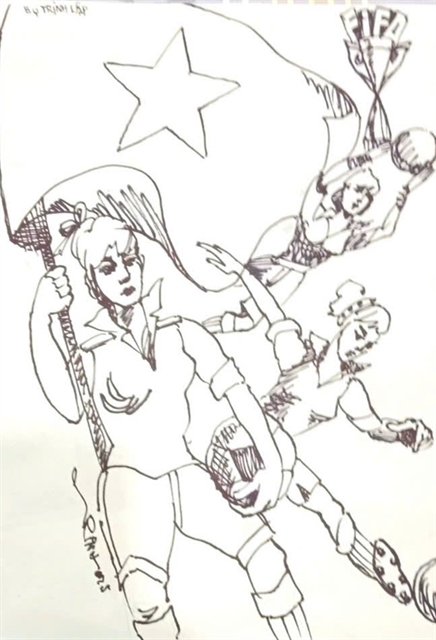 Talk Around Town
Talk Around Town

 |
| Illustration by Trịnh Lập |
By Thanh Nga
Football's world governing body FIFA has thrilled women's football fans by approving a proposal to expand the number of teams in the Women’s World Cup finals from 2031 to 48 teams - a move that presents a unique opportunity for the Vietnamese team as it aims to shine on the world stage.
While the men’s tournament has a rich history dating back to the 1930s, the Women’s World Cup made its debut in 1991. Despite this shorter history, women’s football has made remarkable strides.
The 2015 World Cup saw a significant boost, increasing the number of participating teams from 16 to 24, and in 2023, 32 teams competed in the tournament co-hosted by Australia and New Zealand, marking Việt Nam’s inaugural appearance.
The Vietnamese women's team, often dubbed the 'Golden Girls', has been a rising force in Asian football. Their journey to the 2023 World Cup was a testament to their resilience and determination.
Under the guidance of coach Mai Đức Chung, the team secured their spot by showcasing their skills in the AFC Women's Asian Cup, where they fought hard against some of the continent's best teams. This achievement not only marked a historic moment for Vietnamese football but also sparked greater interest and support for women’s sports in the country.
On May 9, FIFA officially approved the expansion to 48 teams starting in 2031. The United States is expected to host this historic event.
"This is not just about having 16 more teams participating in the World Cup, but the world of women's football is also actively taking the next steps related to the development process. Many FIFA member associations have the opportunity to benefit from the tournament to comprehensively develop their national women's football structure," FIFA President Gianni Infantino said.
With the expanded format, the 2031 World Cup will consist of 12 groups, increasing the total matches from 64 to 104, similar to the 2026 men’s competition. While this change raises concerns about player health and the potential for mismatched games, the thrilling performances at the 2023 World Cup - where teams from every confederation secured victories - demonstrate that women’s football is thriving.
For Asia, the allocation of eight spots at the finals opens doors for teams like Việt Nam, the Philippines, Thailand, and Uzbekistan, all of which could seize this golden opportunity. The Vietnamese women’s team have already made waves by qualifying for the 2023 World Cup, and their journey was a blend of hard work, luck, and a recognition of the obstacles they still face.
Now, Việt Nam's women's team must focus on improving their physical training and experience. Currently, players participate in only 13-15 matches per year at the club level, which limits their development. The lack of advanced training facilities and resources is another hurdle. While the team are investing in training and international friendlies, the real solution lies in nurturing youth talent and enhancing the club system.
Moreover, the current national squad relies heavily on seasoned players like Huỳnh Như and Bích Thùy, who are nearing the end of their careers. Young talents born in 2000-2001 are yet to make their mark, and injuries have hampered key players. While clubs like HCM City thrive on experienced stars, younger teams like Hà Nội struggle to capitalise on their promising generation.
As the next generation struggles to break through, Vietnamese women’s football is exploring player naturalisation. However, this path is fraught with challenges. Players like Chelsea Lê and Trâm Anh are talented but face bureaucratic delays in obtaining citizenship. Their contributions could significantly enhance the national team’s competitiveness.
Yet, the focus cannot solely be on Vietnamese diasporic players. Industry insiders say Việt Nam needs a robust domestic league, increased investment from businesses and a revamped youth training system. Major corporations should recognise the potential for growth in women's football and invest in clubs, academies and facilities.
FIFA has opened the door, but now it is up to the Vietnamese team to step through it. Rejuvenation is essential, but it must be built on a solid foundation. The new generation cannot simply emerge sporadically or rely solely on diasporic talent.
A comprehensive strategy is crucial: improving the national women’s tournament, investing in youth development, expanding coaching education and providing more international competition opportunities.
The Vietnamese team captured the hearts of fans, inspiring a new generation of players. With the 2031 World Cup on the horizon, the potential for growth in Vietnamese women’s football is immense. If these steps are taken, the dream of competing in World Cup could become a thrilling reality. VNS

.jpg)

.jpg)
